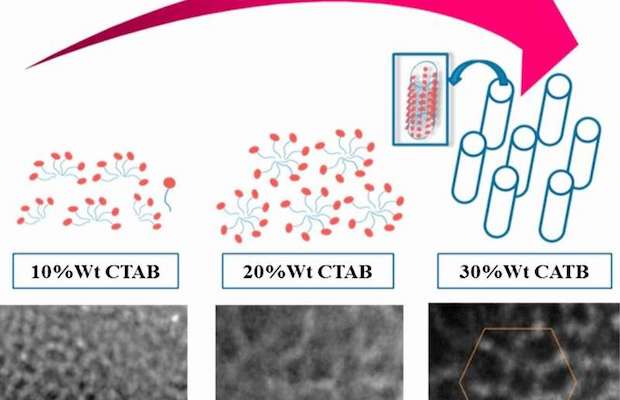
This new material can be used in many energy-saving applications.

A schematic illustration of the formation of spherical and hexagonally arranged rod-like micelles at different concentrations of CTAB. Credit: FEFU.
Scientists of the Far Eastern Federal University (FEFU), together with Russian and foreign colleagues, have developed samples of nickel mesoporous film structures, which have a useful surface area up to 400 times greater than their solid analogue. This new material can be used in many energy-saving applications, and more importantly in increasing the capacity of Solar cells.
According to Alexander Samardak, an associate professor of the Computer Systems Department at the School of Natural Sciences of FEFU, the creation of magnetic porous systems is an up-and-coming field, which is yet poorly studied. The structure of nanoporous materials is similar to a conventional sponge, which can accommodate significant volumes of substances. Thus, the useful surface area of the sponge is much larger than its size.
“The pores we obtained are very small, four to five nanometers, but thanks to them the total surface area of the material is increased 400 times. These unique properties grant the wide potential application of the material. Using such materials, one can create filters for cleaning and adsorption of ultrafine magnetic particles, media for storing substances, in particular, for hydrogen engines, where fuel storage cells are needed. In the future, they may be applied in the production of solar cells and batteries, in nanoelectronics and the automotive industry,” said Samardak.
The unique material is obtained via electrodeposition of nickel particles on an artificial framework of a surfactant (SAS), which gives a structure of nanotube array composed by micelles. After electrodeposition, the framework dissolves in water and leaves behind only mesoporous nickel.
Scientists have determined that when using a certain concentration of surfactants (30 weight percent), the nickel frame structure does not grow randomly, but in the form of hexagonally ordered nanotubes. This unique feature was observed by high-resolution transmission electron microscope operated by Dr. Alexey Ognev from FEFU. This opens up additional possibilities for this material application in the field of magnetic sensors and activators for nanoelectronics.
The research results are published in Applied Surface Science journal.



























